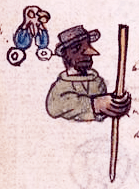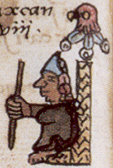Antonio Valeriano facts for kids
Quick facts for kids
Antonio Valeriano
|
|
|---|---|

Valeriano depicted in the Aubin Codex.
|
|
| Judge-governor of San Juan Tenochtitlan | |
| In office 1573–1599 |
|
| Preceded by | Francisco Jiménez |
| Succeeded by | Gerónimo López |
| Judge-governor of Azcapotzalco | |
| In office 1565–? |
|
| Personal details | |
| Born | ca. 1521 Azcapotzalco |
| Died | 1605 |
| Nationality | New Spanish |
Antonio Valeriano (born around 1521, died 1605) was an important Nahua scholar and leader. He lived in New Spain, which is now Mexico, during the time it was a Spanish colony.
Valeriano worked with a Spanish priest named Bernardino de Sahagún. Together, they created a huge book called General History of the Things of New Spain. This book is also known as the Florentine Codex. It has twelve volumes and shares a lot about the history and culture of the Nahua people.
Antonio Valeriano also served as a judge-governor. He led his hometown, Azcapotzalco, and later Tenochtitlan. Tenochtitlan was the former capital of the Aztec Empire.
Valeriano's Education and Work
Antonio Valeriano was a very talented student. He studied at the Franciscan Colegio de Santa Cruz de Tlatelolco. This was a special school for native scholars. At the school, Valeriano learned to read and write in three languages. These were Nahuatl (his native language), Spanish, and Latin.
His teacher, Bernardino de Sahagún, thought very highly of him. Sahagún called Valeriano "one of my collaborators." He said Valeriano was "the principal and most learned" of his students. Another Franciscan priest, Juan Bautista, also praised Valeriano.
Valeriano and other students helped the Franciscans create many important texts. They wrote religious books and dictionaries. Their biggest project was Sahagún's General History of the Things of New Spain. This book is a key source of information about ancient Mexico.
Leading Tenochtitlan

Antonio Valeriano became the judge-governor of San Juan Tenochtitlan in 1573. He held this important position until 1599. Before this time, the city was usually ruled by descendants of the old Aztec emperors. These rulers were called tlatoani.
After 1565, the city started to have non-royal governors. Valeriano's predecessor, Francisco Jiménez, was the first to be called juez-gobernador. Valeriano was not from a royal family himself. However, he was connected to the old Aztec royalty. He married a daughter of a former tlatoani and governor, Diego de Alvarado Huanitzin.
As a judge-governor, Valeriano worked between two cultures. He spoke both Spanish and Nahuatl. He helped keep some parts of the old Nahua culture alive. But he also helped introduce Spanish ways. He dressed like a Spaniard. Yet, some pictures show him looking like a tlatoani. One image in the Aubin Codex shows him with a crown and on a throne. This shows how important he was seen by some in Tenochtitlan.
The Nican Mopohua Text
There is a famous Nahuatl text called Nican Mopohua. It tells the story of the Virgin Mary appearing to Juan Diego in 1531. This text was published in 1649 by Luis Laso de la Vega.
For a long time, many scholars believed Antonio Valeriano wrote the Nican Mopohua. This idea comes from old traditions and writings. Some people, like Luis Becerra Tanco and Carlos de Sigüenza y Góngora, said they saw manuscripts in Valeriano's handwriting.
However, some people have questioned if Valeriano really wrote it. They argue that the text's ideas might not fit with someone who was close to the Franciscans, like Valeriano. Despite these questions, most Mexican scholars still believe that Antonio Valeriano is the author of the Nican Mopohua.
See Also
 In Spanish: Antonio Valeriano para niños
In Spanish: Antonio Valeriano para niños

